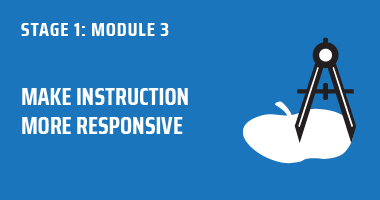Lesson 3 - Using Culture as a Scaffold to Make Content Sticky
MAKE INSTRUCTION MORE RESPONSIVE
TIMING/TASKS: Video Length 13 minutes. To complete this lesson: 1) Watch video to end; 2) Read additional text below; 3) Download & complete exercise(s) in right column
Relevance Means Connecting the Unknown to the Known
OUTCOMES
LESSONS IN THIS MODULE
Lesson 3 – Using Culture as a Scaffold to Make Content Sticky
DOWNLOADS / RESOURCES
RESOURCES
EXERCISES
I understand the concept of “cognitive hooks” and their relationship to information processing.
I can collect the right information to craft cognitive hooks for my students as a community of learners.
In Lesson 2 I introduced the idea of cognitive mediation — your ability to help the student initiate and maintain the information processing cycle through all three stages.
How does that look in practice? Well, it begins with you — the personal trainer of students’ cognitive development. You’ll be creating cognitive hooks that help the student build a bridge between what they already know and the new information that you want them to learn.
This is, in essence, what it means to make something “relevant.”
Unfortunately, in the superficial ways culturally responsive teaching is often applied, it has come to mean simply mentioning something about the student’s race or cultural identity. This is typically one of those pitfall points in creating culturally responsive instruction. Content can be relevant without having a social justice theme or being overtly racialized. There are times we want to do that. But that is not the same as creating ways that help students turn inert information, delivered in a new unit or lesson, into usable information.
While we want to incorporate content topics that are interesting to students and that they can relate to, we have to recognize that just providing something “relatable” doesn’t create a cognitive hook that makes learning sticky for the student. Those cognitive hooks aid in moving the information (content) from the attention phase of information processing where he says, “Hey, that was interesting” to the elaboration phase where he begins to make sense of the content, and says something like “Oh, I see how this is connected to ___.” This type of statement is evidence that chewing and mixing is happening in the student’s working memory.
We will dig deeper into the chewing (elaboration) phase of this work in Stage 2. For now, the foundational piece you want to lay down is your ability to craft cognitive hooks. This lesson outlines the process for gathering the raw data (what they know) that allows you to begin crafting the type of mediation between the content and the student at the center of the instructional core.
ACTION ITEM
Conduct at least one session to gather information from students using the cultural empathy map
Save to My Content

